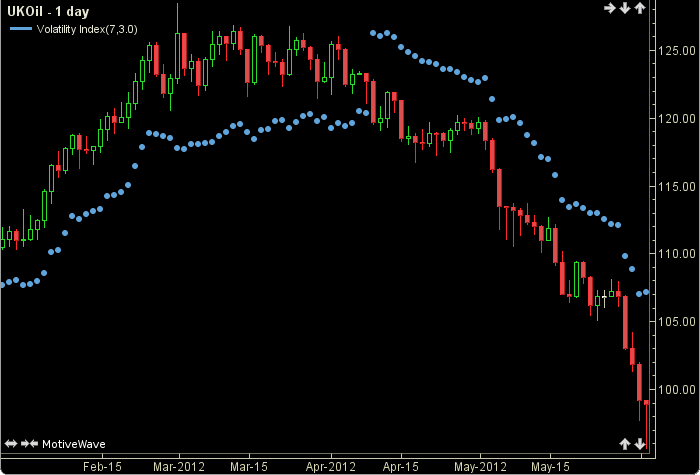Volatility Index
The Volatility Index system is a trend-following system where the position is reversed at every stop. This overlay works as described in the book New Concepts in Technical Trading Systems by J Welles Wilder Jr. SAR (Stop and Reverse) points are calculated as follows: if (isLong) SAR = SIC – ATR(period)*C else SAR = SIC + ATR(period)*C. The user may change the period length and constant value. This indicator’s definition is further expressed in the raw code given in the calculation below.

How To Trade Using Volatility Index
Volatility Index The Volatility Index may be used for an exit strategy. If a close is less than or equal to the SAR a sell to exit (exit long) signal will be generated. Conversely, if the close is more than or equal to the SAR a buy to cover (exit short) signal will be given.
How To Access in MotiveWave
Go to the top menu, choose Study>Welles Wilder>Volatility Index
or go to the top menu, choose Add Study, start typing in this study name until you see it appear in the list, click on the study name, click OK.
Important Disclaimer: The information provided on this page is strictly for informational purposes and is not to be construed as advice or solicitation to buy or sell any security. Please see our Risk Disclosure and Performance Disclaimer Statement.
Calculation
//period = user defined, default is 7
//constant = user defined, default is 3
//LT = less than, LOE = less or equal
//MT = more than, MOE = more or equal
protected void calculate(int index, DataContext ctx)
int period = getSettings().getInteger(Inputs.PERIOD, 7);
if (index LT period) return;
DataSeries series = ctx.getDataSeries();
// The VX is only relevant for completed bars
if (!series.isBarComplete(index)) return;
Double SAR = series.getDouble(index-1, Values.SAR); // Stop And Reverse
Double ATR = series.getDouble(index-1, Values.ATR); // Average True Range
double C = getSettings().getDouble(CONSTANT, 3.0);
Double SIC = series.getDouble(index-1, Values.SIC); // Significant Close
Boolean isLong = series.getBoolean(index-1, Values.LONG);
Instrument instr = ctx.getInstrument();
boolean latest = index == series.size()-1;
if (SAR == null)
// first entry point, calculate the first SAR
isLong = series.getClose(index) MT series.getClose(index-1);
ATR = series.atr(period);
SIC = (double)series.getClose(index-1);
if (isLong) SAR = (double)instr.round(SIC-ATR*C);
else SAR = (double)instr.round(SIC+ATR*C);
end
else
ATR = ((period-1)*ATR + series.getTrueRange(index))/period;
end
double ARC = ATR*C;
double close = series.getClose(index);
if (isLong)
if (close LOE SAR)
// Stop and Reverse
isLong = false;
series.setBoolean(index, Signals.SAR_LONG, true);
if (!latest)
ctx.signal(index, Signals.SAR_LONG, get("SIGNAL_SAR_LONG", instr.format(close), instr.format(SAR)), close);
end
SIC = close;
SAR = instr.round(SIC + ARC);
end
else
SIC = Util.max(SIC, close);
SAR = instr.round(SIC - ARC);
end
end
else
if (close MOE SAR)
// Stop and Reverse
isLong = true;
series.setBoolean(index, Signals.SAR_SHORT, true);
if (!latest) {
ctx.signal(index, Signals.SAR_SHORT, get("SIGNAL_SAR_SHORT", instr.format(close), instr.format(SAR)), close);
end
SIC = close;
SAR = instr.round(SIC - ARC);
end
else
SIC = Util.min(SIC, close);
SAR = instr.round(SIC + ARC);
end
end
series.setDouble(index, Values.SAR, SAR);
series.setDouble(index, Values.SIC, SIC);
series.setDouble(index, Values.ATR, ATR);
series.setBoolean(index, Values.LONG, isLong);
series.setComplete(index);
end
end
